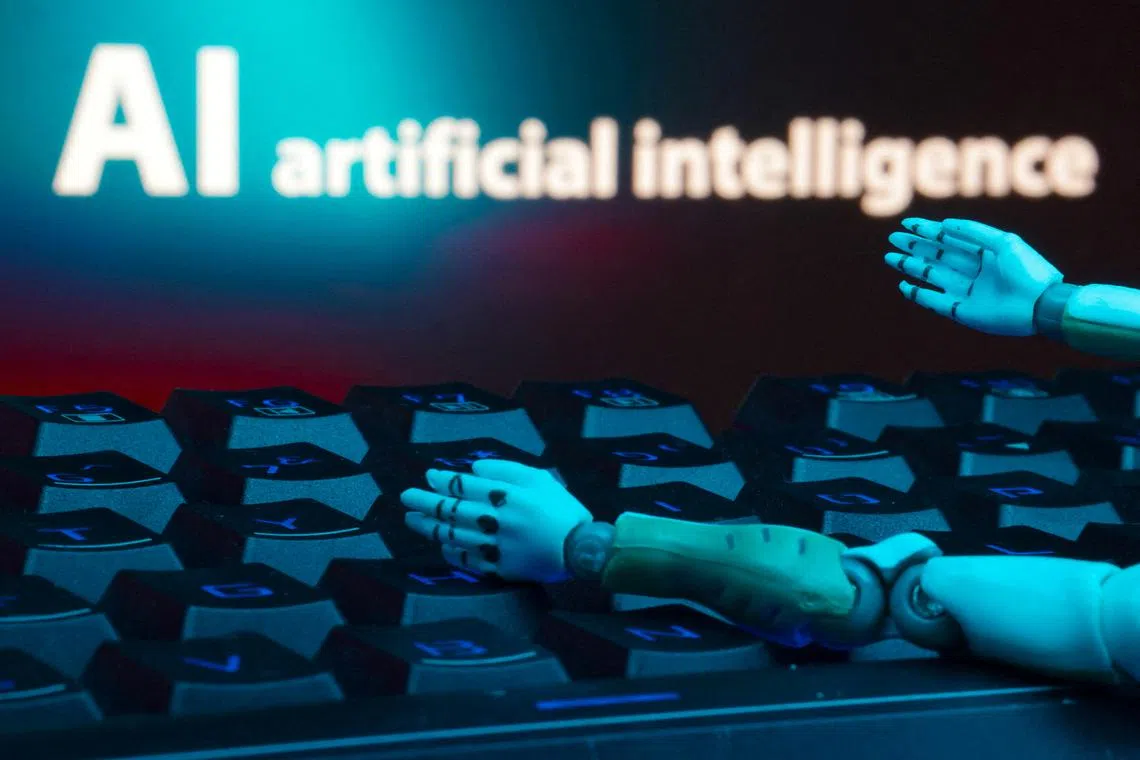India joins global race to develop AI models
Sign up now: Get insights on Asia's fast-moving developments

India's entry into the artificial intelligence race comes at a time of intense rivalry between China and the United States.
PHOTO: REUTERS
Follow topic:
NEW DELHI – India is accelerating its efforts to catch up with global artificial intelligence (AI) players by supporting researchers and private companies in the country to develop foundational models based on local needs.
Information Technology Minister Ashwini Vaishnaw told reporters on Jan 30 that six Indian entities have already shown progress and could release their foundational models by the end of 2025.
“The foundational models made in India will be able to compete with the best of the best in the world,” he claimed, detailing the government’s plans to support these initiatives, including through allocation of computing resources and funding.
India’s entry into this race comes at a time of intense rivalry between China and the US
Known for their adaptability, these models are large artificial neural networks trained on vast amounts of data and are designed to handle a wide variety of applications, ranging from translating text to writing scientific papers.
Mr Vaishnaw added that the government has already secured 18,693 graphics processing units (GPUs) necessary to power AI research and development, exceeding its initial target of 10,000 GPUs under its IndiaAI Mission for the financial year ending March 2025.
The government is expected to soon launch a portal allowing start-ups and researchers to access this computing power at prices lower than global benchmark rates.
The Indian minister’s remarks came days after DeepSeek, a subsidiary of Chinese AI-driven trading company High-Flyer, released its disruptive open-source DeepSeek-R1 model
This is significantly lower than the US$100 million spent by US companies such as OpenAI on its GPT4 model.
The low-cost nature of DeepSeek has generated excitement in India, with expectations that the country can pull off similar cost-efficient success with its large tech talent pool of an estimated five million programmers.
India’s AI market is projected to touch US$17 billion by 2027, growing at an annualised rate of 25 per cent to 35 per cent between 2024 and 2027, IT industry body Nasscom and consulting firm BCG said in a February 2024 report.
Experts have, however, said the country will have to overcome several challenges to set up a cutting-edge AI ecosystem, including putting in place the vast amount of data necessary to develop foundational models, sharpening its talent base and increasing funding for further AI research.
Professor P.J. Narayanan, director of the International Institute of Information Technology, Hyderabad, said a primary challenge for India is ensuring the availability of quality data that can be used to develop foundation models appropriate for India.
“Data is not just some binary bits... It is quality data, it is curated, it is vetted and all kinds of data are required to build something like ChatGPT or any large foundational model,” he told The Straits Times.
The availability of such data is critical to ensure that models developed in the country are trained on Indian datasets, not foreign ones, ensuring linguistic, cultural, and contextual relevance.
Prof Narayanan, who headed a 2023 government AI expert group, added that India must also ensure investments necessary to boost the developing AI sector are also not held back in the pursuit of “frugal innovation”.
“Frugal innovation is good, but that cannot be the primary motive,” he added. “India does need significant investments in hardware resources to make rapid progress, while being creative about using these resources effectively.”
Funding for AI remains meagre in the country. The government had in March 2024 announced its IndiaAI Mission, with a budget of just 103.72 billion rupees (S$1.63 billion). In comparison, Microsoft alone has earmarked US$80 billion for AI in its current fiscal year, while Meta has pledged as much as US$65 billion.
But big Indian tech players have started investing in AI.
In January, Bloomberg reported that the Reliance Group is buying Nvidia’s powerful AI semiconductors and building the world’s biggest data centre by capacity in the western state of Gujarat at an estimated cost of between US$20 billion and US$30 billion to capitalise on booming demand for AI services.
And several Indian start-ups have begun releasing AI-powered tools. In October 2024, Bengaluru-based start-up Sarvam AI launched a new large language model (LLM), Sarvam 1, that is open-source and has been trained in 10 Indian languages, besides English.
The government also announced on Jan 30 that it had selected 18 proposals to develop AI-related applications in sectors such as agriculture and climate change.
Academic courses in AI have also boomed in the country. In 2023, India saw the creation of the Universal AI University, “India’s first dedicated AI-led university”, which integrates AI into all of its subjects and supports this with experiential learning and strong industry connections.
AI experts Balaraman Ravindran and Krishnan Narayanan noted that India has a strong AI talent pool in an article they co-authored for The Indian Express on Jan 31, but added that it is mostly focused on building applications on top of existing AI systems.
“While India can use existing LLMs very well for this purpose, we need to focus on fundamental research in order to create our own cutting-edge AI foundation models,” they added.
“There is a strong need for increased AI research funding and a shift in our approach to AI development.”


